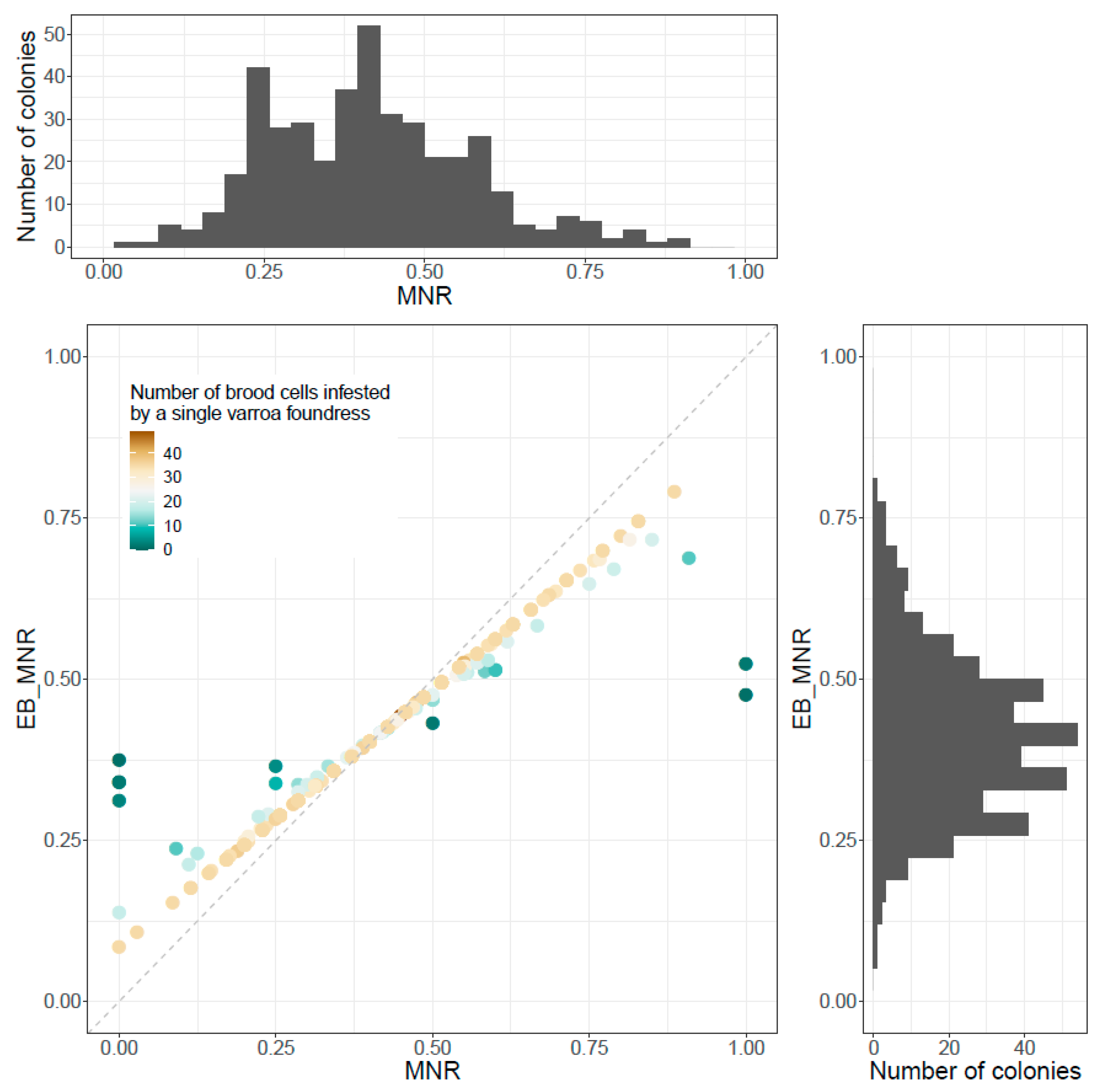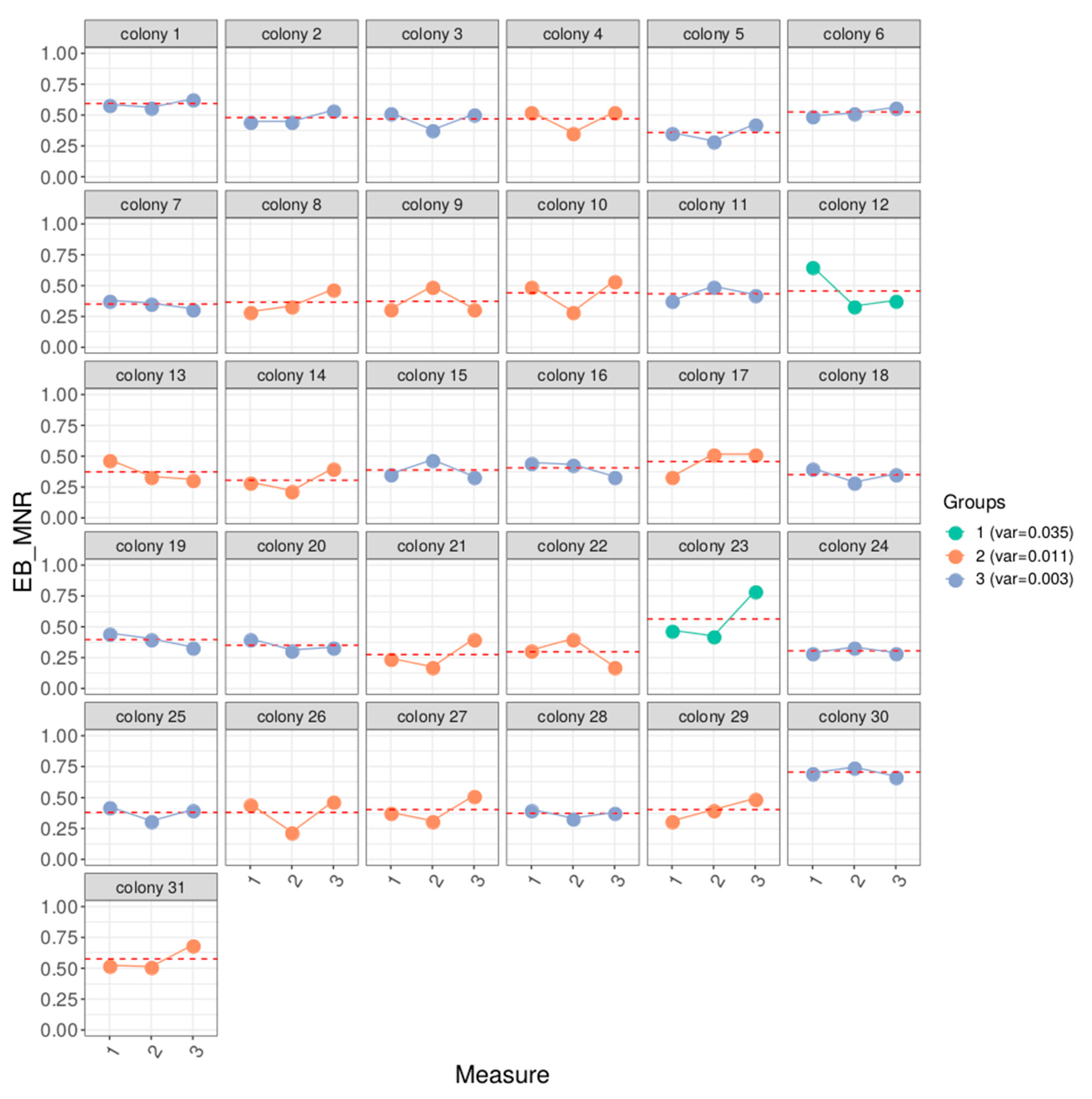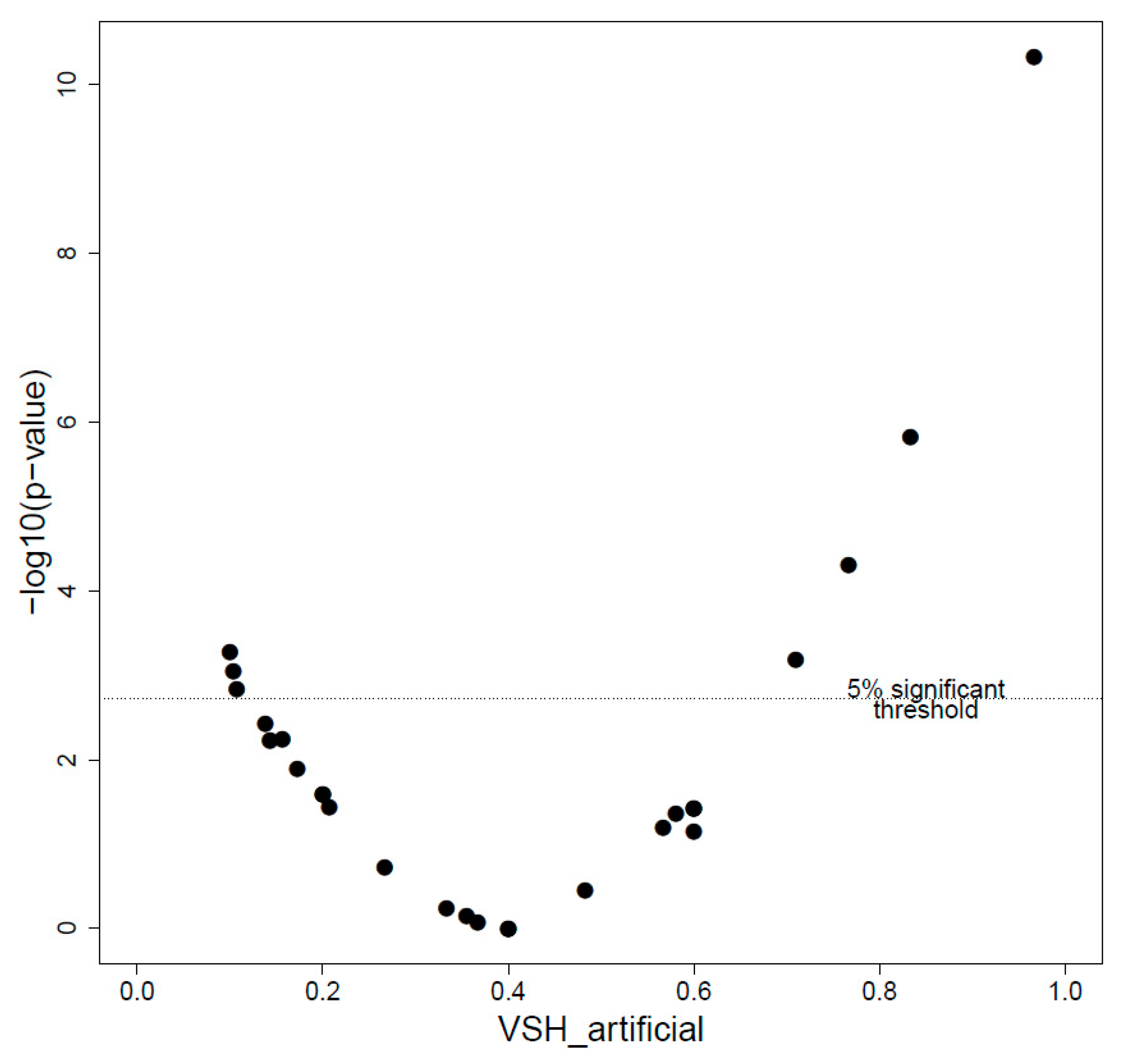Descriptive Analysis of the Varroa Non-Reproduction Trait in Honey Bee Colonies and Association with Other Traits Related to Varroa Resistance
Abstract
:Simple Summary
Abstract
1. Introduction
2. Materials and Methods
2.1. MNR Measurements
2.2. Variance of MNR Measurements
2.3. Other Measures of Varroa Resistance and Colony Dynamics
2.3.1. Hygienic behavior
2.3.2. Varroa Sensitive Hygiene
2.4. Colony and Mite Monitoring
2.5. Statistical Analysis
2.5.1. MNR Variance
2.5.2. MNR Score Correction
2.5.3. Repeatability of Mite Resistance at Different Scales
2.5.4. Correlations between EB_MNR and Other Resistance Traits
2.5.5. Effects on Resistance Traits
3. Results
3.1. Variance of the MNR Score
3.2. MNR Score Correction
3.3. Repeatability of Mite Resistance Traits
3.3.1. EB_MNR Repeatability
3.3.2. Hygienic Behavior Repeatability
3.4. Correlations between Mite Resistance Traits
3.5. Effects on Resistance Traits
3.5.1. EB_MNR
3.5.2. Hygienic Behavior
4. Discussion
5. Conclusions
Supplementary Materials
Author Contributions
Funding
Acknowledgments
Conflicts of Interest
References
- Boecking, O.; Genersch, E. Varroosis—The Ongoing Crisis in Bee Keeping. J. Consum. Prot. Food Saf. 2008, 3, 221–228. [Google Scholar] [CrossRef]
- Le Conte, Y.; Ellis, M.; Ritter, W. Varroamites and honey bee health: Can varroa explain part of the colony losses? Apidologie 2010, 41, 353–363. [Google Scholar] [CrossRef] [Green Version]
- Mondet, F.; Parejo, M.; Meixner, M.D.; Costa, C.; Kryger, P.; Andonov, S.; Servin, B.; Basso, B.; Bienkowska, M.; Bigio, G.; et al. Evaluation of suppressed mite reproduction (SMR) reveals potential for varroa resistance in European honey bee (Apis mellifera L.). Insects 2020. Under revision. [Google Scholar]
- Wilfert, L.; Long, G.; Leggett, H.C.; Schmid-Hempel, P.; Butlin, R.K.; Martin, S.J.M.; Boots, M. Deformed wing virus is a recent global epidemic in honeybees driven by Varroa mites. Science 2016, 351, 594–597. [Google Scholar] [CrossRef] [PubMed] [Green Version]
- Martin, S.J.; Kryger, P. Reproduction of Varroa destructor in South African honey bees: Does cell space influence Varroa male survivorship? Apidologie 2002, 33, 51–61. [Google Scholar] [CrossRef] [Green Version]
- Sammataro, D.; Gerson, U.; Needham, G. Parasitic Mites of Honey Bees: Life History, Implications, and Impact. Annu. Rev. Èntomol. 2000, 45, 519–548. [Google Scholar] [CrossRef] [PubMed]
- Dainat, B.; Evans, J.D.; Chen, Y.P.; Gauthier, L.; Neumann, P. Predictive Markers of Honey Bee Colony Collapse. PLoS ONE 2012, 7, e32151. [Google Scholar] [CrossRef] [PubMed]
- Genersch, E.; Von Der Ohe, W.; Kaatz, H.; Schroeder, A.; Otten, C.; Büchler, R.; Berg, S.; Ritter, W.; Mühlen, W.; Gisder, S.; et al. The German bee monitoring project: A long term study to understand periodically high winter losses of honey bee colonies. Apidologie 2010, 41, 332–352. [Google Scholar] [CrossRef] [Green Version]
- Bajuk, B.P.; Babnik, K.; Snoj, T.; Milčinski, L.; Ocepek, M.P.; Škof, M.; Jenčič, V.; Filazi, A.; Štajnbaher, D.; Kobal, S. Coumaphos residues in honey, bee brood, and beeswax after Varroa treatment. Apidologie 2017, 48, 588–598. [Google Scholar] [CrossRef]
- Le Conte, Y.; De Vaublanc, G.; Crauser, D.; Jeanne, F.; Rousselle, J.-C.; Bécard, J.-M. Honey bee colonies that have survivedVarroa destructor. Apidologie 2007, 38, 566–572. [Google Scholar] [CrossRef] [Green Version]
- Mattila, H.R.; Seeley, T.D. Genetic Diversity in Honey Bee Colonies Enhances Productivity and Fitness. Science 2007, 317, 362–364. [Google Scholar] [CrossRef] [PubMed] [Green Version]
- Locke, B. Natural Varroa mite-surviving Apis mellifera honeybee populations. Apidologie 2015, 47, 467–482. [Google Scholar] [CrossRef] [Green Version]
- Neumann, P.; Blacquière, T. The Darwin cure for apiculture? Natural selection and managed honeybee health. Evol. Appl. 2016, 10, 226–230. [Google Scholar] [CrossRef] [PubMed]
- Calis, J.N.; Fries, I.; Ryrie, S.C. Population modelling of Varroa jacobsoni Oud. Apidologie 1999, 30, 111–124. [Google Scholar] [CrossRef] [Green Version]
- Kurze, C.; Routtu, J.; Moritz, R. Parasite resistance and tolerance in honeybees at the individual and social level. Zoology 2016, 119, 290–297. [Google Scholar] [CrossRef] [PubMed]
- Guichard, M.; Dietemann, V.; Neuditschko, M.; Dainat, B. Three Decades of Selecting Honey Bees that Survive Infestations by the Parasitic Mite Varroa destructor: Outcomes, Limitations and Strategy. Preprint 2020, 1–83. [Google Scholar] [CrossRef] [Green Version]
- Harbo, J.R.; Harris, J.W. Suppressing Mite Reproduction: SMR an Update. Bee Cult. 2002, 130, 46–48. [Google Scholar]
- Mondragón, L.; Spivak, M.; Vandame, R. A multifactorial study of the resistance of honeybees Apis mellifera to the mite Varroa destructor over one year in Mexico. Apidologie 2005, 36, 345–358. [Google Scholar] [CrossRef] [Green Version]
- Wendel, H.P.; Rosenkranz, P. Invasionsgeschwindigkeit und Fertilität von Varroa-Weibchen in aufeinanderfolgenden Reproduktionszyklen. Apidologie 1990, 21, 372–374. [Google Scholar]
- Harbo, J.R.; Harris, J.W. Heritability in Honey Bees (Hymenoptera: Apidae) of Characteristics Associated with Resistance to Varroa jacobsoni(Mesostigmata: Varroidae). J. Econ. Èntomol. 1999, 92, 261–265. [Google Scholar] [CrossRef] [Green Version]
- Fuchs, S. Non-reproducing Varroa jacobsoni Oud. in honey bee worker cells?status of mites or effect of brood cells? Exp. Appl. Acarol. 1994, 18, 309–317. [Google Scholar] [CrossRef]
- Milani, N.; Della Vedova, G.; Nazzi, F. (Z)-8-Heptadecene reduces the reproduction of Varroa destructor in brood cells. Apidologie 2004, 35, 265–273. [Google Scholar] [CrossRef] [Green Version]
- Oddie, M.; Dahle, B.; Neumann, P. Reduced Postcapping Period in Honey Bees Surviving Varroa destructor by Means of Natural Selection. Insects 2018, 9, 149. [Google Scholar] [CrossRef] [PubMed] [Green Version]
- Mondet, F.; Beaurepaire, A.; McAfee, A.; Locke, B.; Alaux, C.; Blanchard, S.; Danka, B.; Le Conte, Y.; Fanny, M.; Alexis, B.; et al. Honey bee survival mechanisms against the parasite Varroa destructor: A systematic review of phenotypic and genomic research efforts. Int. J. Parasitol. 2020, 50, 433–447. [Google Scholar] [CrossRef] [PubMed]
- Harbo, J.R.; Harris, J.W. Suppressed mite reproduction explained by the behaviour of adult bees. J. Apic. Res. 2005, 44, 21–23. [Google Scholar] [CrossRef]
- Harris, J.W.; Danka, R.G.; Villa, J.D. Honey Bees (Hymenoptera: Apidae) With the Trait of Varroa Sensitive Hygiene Remove Brood with All Reproductive Stages of Varroa Mites (Mesostigmata: Varroidae). Ann. Èntomol. Soc. Am. 2010, 103, 146–152. [Google Scholar] [CrossRef]
- Kirrane, M.J.; De Guzman, L.I.; Whelan, P.M.; Frake, A.M.; Rinderer, T.E. Evaluations of the Removal of Varroa destructor in Russian Honey Bee Colonies that Display Different Levels of Varroa Sensitive Hygienic Activities. J. Insect Behav. 2018, 31, 283–297. [Google Scholar] [CrossRef]
- Kirrane, M.J.; De Guzman, L.I.; Holloway, B.; Frake, A.M.; Rinderer, T.E.; Whelan, P.M. Phenotypic and Genetic Analyses of the Varroa Sensitive Hygienic Trait in Russian Honey Bee (Hymenoptera: Apidae) Colonies. PLoS ONE 2015, 10, e0116672. [Google Scholar] [CrossRef] [Green Version]
- Danka, R.G.; Harris, J.W.; Dodds, G.E. Selection of VSH-derived “Pol-line” honey bees and evaluation of their Varroa-resistance characteristics. Apidologie 2015, 47, 483–490. [Google Scholar] [CrossRef]
- Oddie, M.; Büchler, R.; Dahle, B.; Kovačić, M.; Le Conte, Y.; Locke, B.; De Miranda, J.R.; Mondet, F.; Neumann, P. Rapid parallel evolution overcomes global honey bee parasite. Sci. Rep. 2018, 8, 7704. [Google Scholar] [CrossRef] [Green Version]
- Martin, S.J.; Brettell, L. Deformed Wing Virus in Honeybees and Other Insects. Annu. Rev. Virol. 2019, 6, 49–69. [Google Scholar] [CrossRef] [PubMed]
- Harbo, J.R.; Harris, J.W. Resistance to Varroa destructor (Mesostigmata: Varroidae) when mite-resistant queen honey bees (Hymenoptera: Apidae) were free-mated with unselected drones. J. Econ. Èntomol. 2001, 94, 1319–1323. [Google Scholar] [CrossRef] [PubMed]
- Harbo, J.R.; Harris, J.W. An Evaluation of Commercially Produced Queens That Have the SMR Trait. Am. Bee J. 2003, 143, 2013–2016. [Google Scholar]
- Buchegger, M.; Buechler, R.; Fuerst-Waltl, B.; Kovačić, M.; Willam, A. Relationships between resistance characteristics of honey bees (Apis mellifera) against Varroa mites (Varroa destructor). J. Central Eur. Agric. 2018, 19, 954–958. [Google Scholar] [CrossRef] [Green Version]
- Büchler, R.; Drescher, W. Variance and Heritability of the Capped Developmental Stage in European Apis Mellifera L. and Its Correlation with Increased Varroa Jacobsoni Oud. Infestation. J. Apic. Res. 1990, 29, 172–176. [Google Scholar] [CrossRef]
- Lodesani, M.; Crailsheim, K.; Moritz, R. Effect of some characters on the population growth of mite Varroa jacobsoni in Apis mellifera L colonies and results of a bi-directional selection. J. Appl. Èntomol. 2002, 126, 130–137. [Google Scholar] [CrossRef] [Green Version]
- Ibrahim, A.; Reuter, G.S.; Spivak, M. Field trial of honey bee colonies bred for mechanisms of resistance againstVarroa destructor. Apidologie 2007, 38, 67–76. [Google Scholar] [CrossRef] [Green Version]
- Ibrahim, A.; Spivak, M. The relationship between hygienic behavior and suppression of mite reproduction as honey bee (Apis mellifera) mechanisms of resistance toVarroa destructor. Apidologie 2005, 37, 31–40. [Google Scholar] [CrossRef] [Green Version]
- Büchler, R.; Costa, C.; Mondet, F.; Kezic, N.; Kovacic, M. New Smr Protocol. Available online: https://www.beebreeding.net/index.php/2017/09/01/n (accessed on 22 June 2020).
- Dietemann, V.; Nazzi, F.; Martin, S.J.; Anderson, D.L.; Locke, B.; Delaplane, K.S.; Wauquiez, Q.; Tannahill, C.; Frey, E.; Ziegelmann, B.; et al. Standard methods for varroa research. J. Apic. Res. 2013, 52, 1–54. [Google Scholar] [CrossRef] [Green Version]
- Andere, C.; Palacio, M.; Rodriguez, E.; Dominguez, M.T.; Figini, E.; Bedascarrasbure, E. Evaluation of honey bee defensive behavior in Argentina—A field method. Am. Bee J. 2000, 140, 975–978. [Google Scholar]
- Hernandez, J.; Maisonnasse, A.; Cousin, M.; Beri, C.; Le Quintrec, C.; Bouetard, A.; Castex, D.; Decante, D.; Servel, E.; Buchwalder, G.; et al. ColEval: Honeybee COLony Structure EVALuation for Field Surveys. Insects 2020, 11, 41. [Google Scholar] [CrossRef] [Green Version]
- The R Project for Statistical Computing. Available online: http://www.r-project.org/ (accessed on 13 February 2012).
- Fox, J.; Weisberg, S. An R Companion to Applied Regression, 3rd ed.; SAGE Publications: Thousand Oaks, CA, USA, 2019. [Google Scholar]
- Venables, W.N.; Ripley, B.D. Modern Applied Statistics with S, 4th ed.; Springer Science and Business Media LLC: Berlin, Germany, 2002. [Google Scholar]
- Josse, J.; Husson, F. missMDA: A Package for Handling Missing Values in Multivariate Data Analysis. J. Stat. Softw. 2016, 70, 1–31. [Google Scholar] [CrossRef]
- Kuznetsova, A.; Brockhoff, P.B.; Christensen, R.H.B. lmerTest Package: Tests in Linear Mixed Effects Models. J. Stat. Softw. 2017, 82, 1–26. [Google Scholar] [CrossRef] [Green Version]
- Zuur, A.F.; Ieno, E.N.; Walker, N.; Saveliev, A.A.; Smith, G.M. Mixed Effects Modelling for Nested Data; Springer Science and Business Media LLC: Berlin, Germany, 2009; pp. 101–142. [Google Scholar]
- Bates, D.; Mächler, M.; Bolker, B.; Walker, S. Fitting Linear Mixed-Effects Models Using lme. J. Stat. Softw. 2015, 67, 1–48. [Google Scholar] [CrossRef]
- Le Conte, Y.; Mondet, F. Natural Selection of Honeybees Against Varroa destructor. In Beekeeping—From Science to Practice; Springer International: Cham, Switzerland, 2017; pp. 189–194. [Google Scholar]
- Facchini, E.; Bijma, P.; Pagnacco, G.; Rizzi, R.; Brascamp, E.W. Hygienic behaviour in honeybees: A comparison of two recording methods and estimation of genetic parameters. Apidologie 2019, 50, 163–172. [Google Scholar] [CrossRef] [Green Version]
- Maucourt, S. Genetic Selection of the Honey Bee (Apis mellifera) in a Northern Climate. In Proceedings of the 46th Apimondia International Apicultural Congress, Montréal, QC, Canada, 8–12 September 2019; Available online: https://www.apimondia.com/en/databases/congresses-proceedings/106-apimondia-2019-montreal-canada-proceedings (accessed on 20 June 2020).
- Rinderer, T.E.; Harris, J.W.; Hunt, G.J.; De Guzman, L.I. Breeding for resistance toVarroa destructorin North America. Apidologie 2010, 41, 409–424. [Google Scholar] [CrossRef] [Green Version]
- Kulincevic, J.M.; Rinderer, T.E.; Urošević, D.J. Seasonality and Colony Variation of Reproducing and Non-Reproducing Varroa Jacobsoni Females in Western Honey Bee (Apis Mellifera) Worker Brood. Apidologie 1988, 19, 173–180. [Google Scholar] [CrossRef] [Green Version]
- Bienefeld, K.; Radtke, J.; Zautke, F. Einfluss der Temperaturregulierung im Bienenvolk auf den Reproduktionserfolg von Varroa jacobsoni Oud. Apidologie 1995, 26, 329–331. [Google Scholar]
- Harris, J.W.; Villa, J.D.; Danka, R.G. Environmental effects on the growth of varroa mite populations. Bee Cult. 2004, 132, 23–25. [Google Scholar]
- Büchler, R. Varroa tolerance in honey bees—Occurrence, characters and breeding. Bee World 1994, 49, 6–18. [Google Scholar] [CrossRef]
- Momot, J.P.; Rothenbuhler, W.C. Behaviour Genetics of Nest Cleaning in Honeybees. VI. Interactions of Age and Genotype of Bees, and Nectar Flow. J. Apic. Res. 1971, 10, 11–21. [Google Scholar] [CrossRef]
- Greatti, M.; Milani, N.; Nazzi, F. Reinfestation of an acaricide-treated apiary byVarroa jacobsoni Oud. Exp. Appl. Acarol. 1992, 16, 279–286. [Google Scholar] [CrossRef]
- Frey, E.; Rosenkranz, P. Autumn invasion rates of Varroa destructor (Mesostigmata: Varroidae) into honey bee (Hymenoptera: Apidae) colonies and the resulting increase in mite populations. J. Econ. Èntomol. 2014, 107, 508–515. [Google Scholar] [CrossRef] [PubMed]
- Peck, D.T.; Smith, M.L.; Seeley, T.D. Varroa destructor Mites Can Nimbly Climb from Flowers onto Foraging Honey Bees. PLoS ONE 2016, 11, e0167798. [Google Scholar] [CrossRef] [PubMed]
- Weller, S. Populationsdynamik der Parasitischen Bienenmilbe Varroa Destructor in Vorselektierten Bienenvölkern (A. mellifera L.) unter Besonderer Berücksichtigung der Reproduktion. Master’s Thesis, Apicultural State Institute, University of Hohenheim, Stuttgart, Germany, 2008. [Google Scholar]
- Ward, K.; Danka, R.; Ward, R. Comparative performance of two mite-resistant stocks of honey bees (Hymenoptera: Apidae) in Alabama beekeeping operations. J. Econ. Entomol. 2008, 101, 654–659. [Google Scholar] [CrossRef] [PubMed]
- Leclercq, G.; Pannebakker, B.; Gengler, N.; Nguyen, B.K.; Francis, F. Drawbacks and benefits of hygienic behavior in honey bees (Apis mellifera L.): A review. J. Apic. Res. 2017, 56, 366–375. [Google Scholar] [CrossRef] [Green Version]
- Wagoner, K.; Spivak, M.; Rueppell, O. Brood Affects Hygienic Behavior in the Honey Bee (Hymenoptera: Apidae). J. Econ. Èntomol. 2018, 111, 2520–2530. [Google Scholar] [CrossRef] [Green Version]
- Villa, J.D.; Danka, R.G.; Harris, J.W. Repeatability of measurements of removal of mite-infested brood to assess Varroa Sensitive Hygiene. J. Apic. Res. 2017, 56, 631–634. [Google Scholar] [CrossRef]




| Minimum | Mean | Maximum | Standard Deviation | Coefficient of Variation | |
|---|---|---|---|---|---|
| MNR_first (35 cells) (n = 39) | 0.171 | 0.394 | 0.686 | 0.141 | 0.357 |
| MNR_tot (n = 39) | 0.165 | 0.373 | 0.680 | 0.123 | 0.331 |
| MNR_10 (n = 39 × 100) | 0.000 | 0.370 | 1.000 | 0.142 [0.138; 0.145] | 0.420 [0.380; 0.460] |
| MNR_35 (n = 39 × 100) | 0.000 | 0.374 | 0.886 | 0.062 [0.060; 0.064] | 0.180 [0.164; 0.197] |
| MNR_50 (n = 39 × 100) | 0.080 | 0.373 | 0.820 | 0.044 [0.041; 0.046] | 0.128 [0.115; 0.141] |
| MNR_80 (n = 32 × 100) | 0.125 | 0.356 | 0.725 | 0.020 [0.017; 0.022] | 0.060 [0.051; 0.070] |
| Random Effects | Standard Deviation | 95% Confidence Interval | ||
| Colony | 0.044 | [0.024; 0.058] | ||
| Breeders group | 0.034 | [0.004; 0.054] | ||
| Scoring period | 0.036 | [0.014; 0.057] | ||
| Observer | 0.030 | [0.000; 0.050] | ||
| Residuals | 0.090 | [0.083; 0.099] | ||
| Fixed Effects | Coefficient | Standard Error | Degree of Freedom | p-value |
| Intercept | 0.395 | 0.018 | 19.560 | <10−15 |
| Number recapped cells | 0.015 | 0.005 | 420.554 | 0.007 |
| In hive honey | −0.022 | 0.006 | 257.714 | 0.001 |
| Random Effects | Standard Deviation | 95% Confidence Interval | ||
| Colony | 0.075 | [0.000; 0.116] | ||
| Queen’s genetic origin | 0.069 | [0.000; 0.107] | ||
| Testing apiary | 0.087 | [0.032;0.139] | ||
| Residuals | 0.210 | [0.190; 0.230] | ||
| Fixed Effects | Coefficient | Standard Error | Degree of Freedom | p-value |
| Intercept | 0.731 | 0.034 | 8.0.38 | <10−8 |
| Phoretic varroa infestation | −0.042 | 0.012 | 305.427 | 5 × 10−4 |
© 2020 by the authors. Licensee MDPI, Basel, Switzerland. This article is an open access article distributed under the terms and conditions of the Creative Commons Attribution (CC BY) license (http://creativecommons.org/licenses/by/4.0/).
Share and Cite
Eynard, S.E.; Sann, C.; Basso, B.; Guirao, A.-L.; Le Conte, Y.; Servin, B.; Tison, L.; Vignal, A.; Mondet, F. Descriptive Analysis of the Varroa Non-Reproduction Trait in Honey Bee Colonies and Association with Other Traits Related to Varroa Resistance. Insects 2020, 11, 492. https://doi.org/10.3390/insects11080492
Eynard SE, Sann C, Basso B, Guirao A-L, Le Conte Y, Servin B, Tison L, Vignal A, Mondet F. Descriptive Analysis of the Varroa Non-Reproduction Trait in Honey Bee Colonies and Association with Other Traits Related to Varroa Resistance. Insects. 2020; 11(8):492. https://doi.org/10.3390/insects11080492
Chicago/Turabian StyleEynard, Sonia E., Christina Sann, Benjamin Basso, Anne-Laure Guirao, Yves Le Conte, Bertrand Servin, Lea Tison, Alain Vignal, and Fanny Mondet. 2020. "Descriptive Analysis of the Varroa Non-Reproduction Trait in Honey Bee Colonies and Association with Other Traits Related to Varroa Resistance" Insects 11, no. 8: 492. https://doi.org/10.3390/insects11080492
APA StyleEynard, S. E., Sann, C., Basso, B., Guirao, A.-L., Le Conte, Y., Servin, B., Tison, L., Vignal, A., & Mondet, F. (2020). Descriptive Analysis of the Varroa Non-Reproduction Trait in Honey Bee Colonies and Association with Other Traits Related to Varroa Resistance. Insects, 11(8), 492. https://doi.org/10.3390/insects11080492






